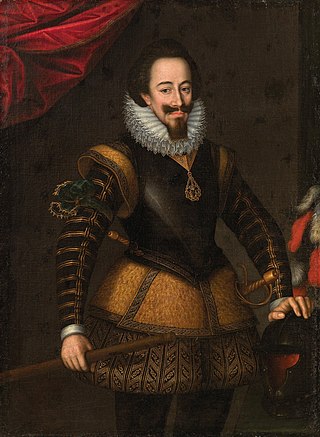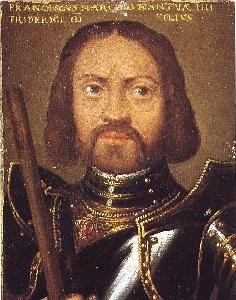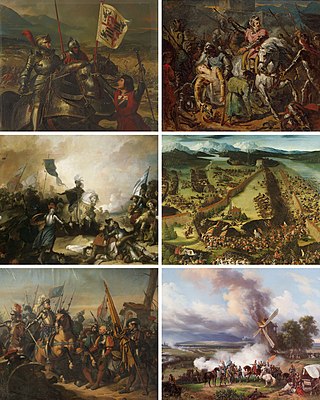

Ludovico II del Vasto (23 March 1438 in Saluzzo – 27 January 1504) was marquess of Saluzzo from 1475 until his death. Before his accession as marquis he held the title of Count of Carmagnola.


Ludovico II del Vasto (23 March 1438 in Saluzzo – 27 January 1504) was marquess of Saluzzo from 1475 until his death. Before his accession as marquis he held the title of Count of Carmagnola.
Ludovico was the son of Ludovico I of Saluzzo and Isabella of Montferrat. He continued his father's war against Charles I of Savoy, which had depleted Saluzzo's fortunes, but again without notable results. Following his father's death in April 1475, Ludovico became marquess of Saluzzo. [1] In an effort to foster trade, he patronized the construction of an alpine tunnel under Monviso which was completed in 1480. [1]
In 1481, Ludovico married his cousin, Giovanna Palaiologo of Montferrat, daughter of William VIII, Marquess of Montferrat. He married Margaret of Foix-Candale in 1492. [2] [3]
Worsening relations with duke Charles of Savoy hastened Ludovico's allegiance to the French king Charles VIII. [1] In 1487, Ludovico asked Charles for an army to relieve the siege of Saluzzo, but the city fell to Louis Tailland on 3 April 1487. [1] Ludovico fled to Provence and remained in exile until 1490. [1]
In 1499, Ludovico was with the French forces of Louis XII of France that invaded the Duchy of Milan. [4] Following the French loss of Naples, Ludovico was sent to Gaeta and reinforced the city upon his arrival. [5] Francesco II Gonzaga, Marquess of Mantua, leading a French army to Gaeta, resigned his command to Ludovico. [6] Ludovico encamped his army across from the Spanish separated by the Garigliano river. [7] The Spanish, with the building of a pontoon bridge, were able to launch a surprise attack on Ludovico's army and defeated it at the Battle of Garigliano in 1503. [7]
Ludovico died in Genoa in January 1504 and was succeeded by his and Marguerite's eldest child, Michele Antonio I of Saluzzo. [3]
A monument to him is located in the church of San Giovanni at Saluzzo, commissioned by his wife Margaret and executed by Benedetto Briosco in 1508. Ludovico II was also the initiator of the Neo-Gothic Cathedral of Saluzzo and of the first Alpine tunnel, the Buco di Viso (2,880 metres above sea level).
Ludovico and Margaret had:

Charles Emmanuel I, known as the Great, was the Duke of Savoy and ruler of the Savoyard states from 30 August 1580 until his death almost 50 years later in 1630. He was nicknamed Testa d'feu for his rashness and military aggression.

Charles III of Savoy, often called Charles the Good, was Duke of Savoy from 1504 to 1553, although most of his lands were ruled by the French between 1536 and his death.

Charles VIII, called the Affable, was King of France from 1483 to his death in 1498. He succeeded his father Louis XI at the age of 13. His elder sister Anne acted as regent jointly with her husband Peter II, Duke of Bourbon until 1491 when the young king turned 21 years of age. During Anne's regency, the great lords rebelled against royal centralisation efforts in a conflict known as the Mad War (1485–1488), which resulted in a victory for the royal government.

Francesco II Gonzaga was the ruler of the Italian city of Mantua from 1484 until his death.

The Italian Wars were a series of conflicts fought between 1494 and 1559, mostly in the Italian Peninsula, but later expanding into Flanders, the Rhineland and Mediterranean Sea. The primary belligerents were the Valois kings of France, and their Habsburg opponents in the Holy Roman Empire and Spain. At different points, various Italian states participated in the war, some on both sides, with limited involvement from England and the Ottoman Empire.

Saluzzo is a town and former principality in the province of Cuneo, in the Piedmont region, Italy.

The First Italian War, sometimes referred to as the Italian War of 1494 or Charles VIII's Italian War, was the opening phase of the Italian Wars. The war pitted Charles VIII of France, who had initial Milanese aid, against the Holy Roman Empire, Spain and an alliance of Italian powers led by Pope Alexander VI, known as the League of Venice.

The Italian Wars of 1499-1504 are divided into two connected, but distinct phases: the Second Italian War (1499–1501), sometimes known as Louis XII's Italian War, and the Third Italian War (1502-1504) or War over Naples. The first phase was fought for control of the Duchy of Milan by an alliance of Louis XII of France and the Republic of Venice against Ludovico Sforza, the second between Louis and Ferdinand II of Aragon for possession of the Kingdom of Naples.

The Battle of Garigliano was fought on 29 December 1503 between a Spanish army under Gonzalo Fernández de Córdoba and a French army commanded by Ludovico II, Marquis of Saluzzo.

Thomas II was Marquess of Saluzzo from 1336 to his death. He succeeded his father, Frederick I.

Thomas III of Saluzzo (1356–1416) was Marquess of Saluzzo from 1396 until his death.

William VIII Palaiologos was the Marquis of Montferrat from 1464 until his death.
Ludovico I del Vasto was Marquess of Saluzzo from 1416 until his death.

Michele Antonio del Vasto was the Marquess of Saluzzo from 1504 until his death.

Giovanni Ludovico of Saluzzo was marquess of Saluzzo in 1528–1529.
John Jacob Palaeologus was the Margrave of Montferrat from 1418 to 1445.

Margaret of Foix-Candale, was Marchioness of Saluzzo by marriage to Ludovico II. She acted as regent of the Marquisate of Saluzzo during the minority of her son Michele Antonio in 1504-1526.
Boniface III Palaeologus was Marquis of Montferrat from 1483 until his death.

Francesco Ludovico of Saluzzo was Marquis of Saluzzo between 1529 and 1537.